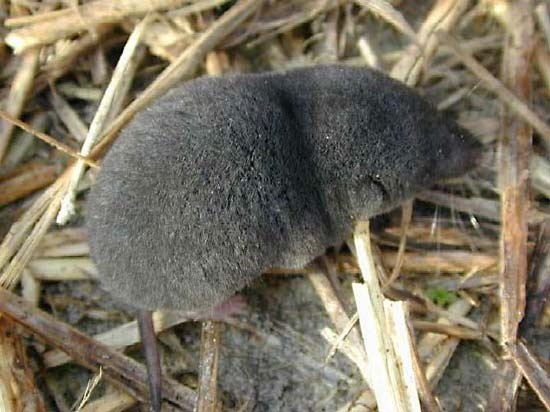short-tailed shrew
mammal
 any of three species of North American insectivores (insectivore) that resemble voles (vole) in body form. All have minute, degenerate eyes and small ears concealed in the fur. Within the moderately long and pointed muzzle are reddish-tipped teeth. Blarina species are among the largest North American shrews (shrew), weighing up to 30 grams (1.1 ounces), with a body 8 to 11 cm (3 to 4 inches) long. The dense, soft, and velvety fur is brownish gray, slate, or black on the upperparts and slightly paler on the underparts. The short, furred tail and feet are gray. The coat is glossy.
any of three species of North American insectivores (insectivore) that resemble voles (vole) in body form. All have minute, degenerate eyes and small ears concealed in the fur. Within the moderately long and pointed muzzle are reddish-tipped teeth. Blarina species are among the largest North American shrews (shrew), weighing up to 30 grams (1.1 ounces), with a body 8 to 11 cm (3 to 4 inches) long. The dense, soft, and velvety fur is brownish gray, slate, or black on the upperparts and slightly paler on the underparts. The short, furred tail and feet are gray. The coat is glossy.Active all year, day or night, short-tailed shrews forage in leaf litter and fallen grass for invertebrates (primarily earthworms, slugs, snails, and insects), and they pursue small salamanders, reptiles, and mice. Their saliva contains a neurotoxin and a hemotoxin that are introduced into a wound by chewing. These toxins are used primarily to immobilize mice and invertebrates, especially snails, which are stored for later use. Their diet also includes roots, beechnuts, berries, sunflower seeds, and fungi. Voracious eaters, short-tailed shrews consume about half their weight each day and must also drink frequently.
Short-tailed shrews travel on the ground, using runways through surface litter and snow. Most of their time, however, is spent underground in burrows (burrowing) they excavate or in those constructed by moles (mole) or voles. Burrows are usually 10 cm below the surface but can be 50 cm deep. Inside they are flat on the top and bottom, not the usual cylindrical form made by other burrowing mammals. The shrews dig with their strong front feet, removing loose soil from the tunnel by either kicking it out with their hind feet or pushing it out with their muzzle. Within tunnel systems, territories are marked by odorous secretions from scent glands on the body, as sight is restricted to light detection. The shrew uses a large repertoire of squeaks, clicks, twitters, and ultrasonic sounds to navigate and to locate prey via echolocation.
Nests, lined with dry vegetation or fur, are made in burrows beneath rotting logs, tree stumps, or rocks or in crevices of building foundations. During copulation the male and female are locked together for up to 25 minutes, and the inactive male is dragged behind the active female. Three to four litters, usually of 5 to 7 (but up to 10) young, are produced between spring and autumn; the gestation period is very short—17 to 22 days.
Short-tailed shrews range from southern Canada through the north-central and northeastern United States to eastern Texas and Florida. They inhabit environments with tall or dense grass in the western portion of the range, hardwood and coniferous forest in the east, and palmetto groves along the Gulf of Mexico. Habitat must provide plenty of cover, and the soil must be well drained but retain enough moisture to keep the burrows humid.
The three species in the genus Blarina are the northern (B. brevicauda), the southern (B. carolinensis), and Elliot's (B. hylophaga) short-tailed shrew. Blarina is one of many genera classified with “true shrews” of the family Soricidae in the order Soricimorpha, which belongs to a larger group of mammals referred to as insectivores. Their evolutionary history extends back to the Late Pliocene Epoch (3.6 to 1.8 million years ago) of North America.
- Gottfried Semper
- Gottfried Silbermann
- Gottfried von Einem
- Gottfried von Haberler
- Gottfried von Strassburg
- Gottfried Wilhelm Leibniz
- Gotthard, Saint
- Gotthelf, Jeremias
- Gotthold Ephraim Lessing
- Gotti, John
- Gottlieb, Adolph
- Gottlieb Daimler
- Gottlieb Haberlandt
- Gottlob Frege
- Gottman, Jean
- Gottschalk, Louis Moreau
- Gottschalk Of Orbais
- Gottsched, Johann Christoph
- gottuvadyam
- Gottwald, Klement
- Gotō Islands
- Gotō Shimpei
- Gotō Shōjirō
- gouache
- Gouda